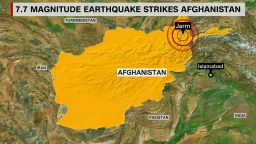Story highlights
NEW: Pakistan death rises to 248; overall deaths now at 364
"I avoided death by inches," says survivor whose shop collapsed
Aid official: Accessing badly affected villages in mountainous areas will be "major challenge"
Noor Wali was sitting inside his shoe shop in northwestern Pakistan when he heard a loud roaring sound and saw cracks appear in the walls.
He ran out of the building just before it collapsed into rubble.
“I avoided death by inches,” he told CNN.
His shop in Khyber Pakhtunkhwa province was one of thousands of structures flattened by the magnitude-7.5 earthquake that struck South Asia on Monday afternoon, killing at least 364 people and injuring more than 2,000 others.

As the death toll continues to rise, officials in Pakistan and Afghanistan are trying to gauge the scale of the devastation and figure out how to get help to hard-hit communities scattered across remote, mountainous areas.
“Many villages in normal circumstances are one or two hours from proper roads,” said Arif Noor, the Pakistan director for the aid group Mercy Corps. “As you can imagine, reaching those people and helping them out is going to be a major challenge.”
Boulders tumbling down on roads
The epicenter of the quake was in northeastern Afghanistan, but the majority of the deaths – at least 248, according to officials – have so far been reported across the border in Pakistan. That may be because the Pakistani areas are more heavily populated than the Afghan ones.
“The population is dense, but at the same time they’re everywhere – up in the mountains, down in the valleys,” Noor said. “With landslides, the situation is even worse.”
Irfan Ullah, a teacher, was on his way home from school in Khyber Pakhtunkhwa when the ground began trembling and boulders started to tumble down the hillside toward the road.
He rushed to avoid the danger but in his panic fell and broke his leg, he told CNN. Luckily, somebody found him and he was taken to a hospital in the Swat Valley.
Schoolgirls die in stampede
Hospitals on both sides of the border were overrun with hundreds of injured people. But medical facilities are few and far between in some of the most severely affected areas.
In Afghanistan, the number of dead rose to 115, Afghan President Ashraf Ghani said Tuesday on Twitter. That included 12 schoolgirls who died in a stampede as they tried to evacuate their school in the northern city of Taluqan, police said.
One death has also been reported in Indian-administered Jammu and Kashmir.
The tremors brought back nightmarish memories of the magnitude-7.6 quake that hit Kashmir in 2005, killing more than 70,000 people and rattling cities across the region.
But Monday’s quake took place far deeper inside the Earth, some 223 kilometers (139 miles) below the surface, lessening its destructive force.
Winter closing in
Many people were still too afraid to go back inside buildings as night fell Monday and aftershocks continued, Noor said.
Aid agencies said the extent of the damage should become clearer by the end of Tuesday, after officials carry out initial surveys of the situation.
Survivors face tough conditions in a region where snow has already begun to fall in some areas.
“They will need protection from the elements, food, clean water and hygiene essentials such as soap,” said Jane Cocking, the aid group Oxfam’s humanitarian director. “It will soon be winter and people will need shelters that will keep them warm from sub-zero temperatures.”
CNN’s Sophia Saifi reported from Islamabad; Masoud Popalzai reported from Kabul, Afghanistan; and Jethro Mullen reported and wrote from Hong Kong. CNN’s Ivan Watson, Mariano Castillo and Saima Mohsin contributed to this report.








